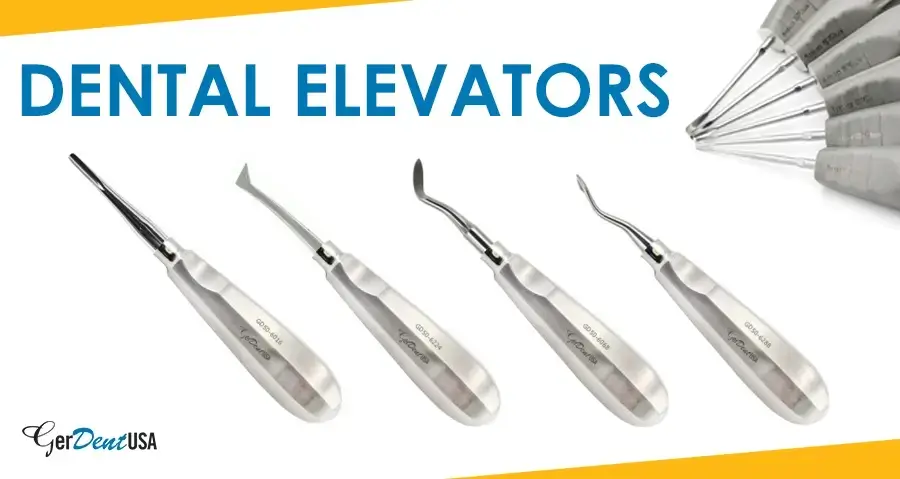How Dental Elevators Evolved Over Time?

Dental elevators have not always looked the way they are now. Instead, they have evolved over the years to this present shape. Now you might be wondering about how this instrument has evolved and many questions might be flashing into your mind about its structure, features, and inventors.
This blog will answer your different queries by bringing you back to the past. But first, let’s look at the purpose of this tool in dentistry.
Dentists use the dental elevator to luxate the tooth during the dental extraction procedure. It loosens the tooth before applying forceps, so dentists can easily remove it. The dental tool doesn’t harm the surrounding tissues while separating the tooth from the periodontal ligament. All these are the primary functions of the dental elevator.
If we talk about the history of dental elevators, the instrument dates back to the Abulcasis’ contribution to the first drawing of elevators. After this, the dental tool underwent different transformations to come into its present form. So, take a glimpse at the different eras of the evolution of dental elevators.
Early Era Dental Elevators
The 16th and 17th-century elevators belong to the category of early-era elevators. Those of the 16th century were referred to as punches or levers. Exposure and Geissfuss are examples of earlier elevators. Geissfuss (goat’s foot) was named due to its appearance.
In 1754, Lecluse introduced the curved design elevator. The design is believed to resemble the latest elevator dental tool. However, it’s still a mystery who introduced the use of dental elevators in dentistry.
But some believe that Thomas Bell was the first to propose its use in dental practices. He applied this dental tool to remove the lower third molar. During that period, they were made with iron or brass, which is different from the material used nowadays.
Evolution In The 18th And 19th Centuries
18th century in the evolution of dental elevators is remarkable. The contribution of William Warwick James is significant in this era as he popularized the use of elevators. Before it, dental surgeons were using tooth keys for removing teeth.
William Warwick James’ elevator is thought to be a modified form of Thompson’s curved elevator. His contribution is associated with the set of three elevators (left curved, straight, and right).
In the 19th century, the name of Matthew H. Cryer was prominent in increasing the use of elevators. Due to his contribution, the present-day Cryer left and right elevators are named after him.
The dental tool had ebony and ivory handles in the eighteenth and nineteenth centuries. In addition, the elevators were significantly modified during these centuries to make them more efficient. Finally, today’s elevators are much more efficient and ergonomic than the old day’s dental tools.
Present Day Elevators
Modern-day elevators find some resemblance in structure to the earlier elevators. But their material is stainless steel to undergo safe sterilization procedures. But you will see that the purpose of this dental tool is still the same, i.e., to lose the tooth from the gums.
The tool is an integral part of dental tool kits. It features a handle, a shank, and a blade to assist dentists in dental extraction procedures. No dental extraction is possible without using elevators. The dental tool also removes the fractured roots without hurting the surrounding tissues.
Want To Get The Best Modern-Day Elevators?
The importance of dental elevators is deep-rooted in dentistry. Using elevators is mandatory before the use of dental forceps for tooth extraction. Now the possible concern is where to find premium quality modern-day elevators. For this, you need not worry, as GerDentUSA offers a wide range of modern dental tools for dental procedures.
You may also get different variations of elevator dental tools besides other dental tools. On top of that, they use German stainless steel for their dental tools. As a result, dental tools are robust, durable, and sterilizable.
They also offer customization to manufacture dental tools according to the customer’s requirements. Further, their tools require low maintenance when used correctly. They are also reusable after sterilization.
FAQ’s
-
What are dental elevators used for?
Dentists use dental elevators for loosening teeth and removing fractured roots. So, they assist dentists in dental extraction procedures.
-
What is the difference between elevators and forceps?
Elevators luxate the tooth, and forceps extract the tooth. Elevators also assist in removing fractured roots. They are also different in their appearance.
-
Are elevators used before forceps or after?
Dentists use elevators before applying forceps to loosen the tooth from the gum. The dental tool doesn’t harm the surrounding tissues or gums.






